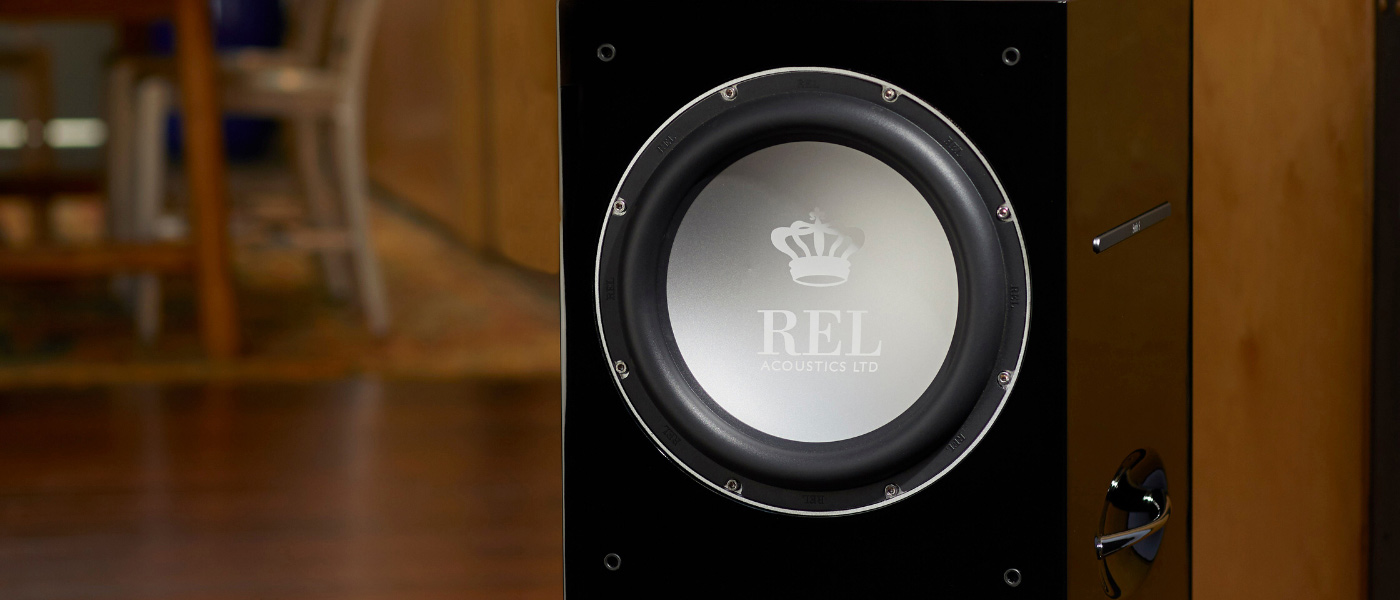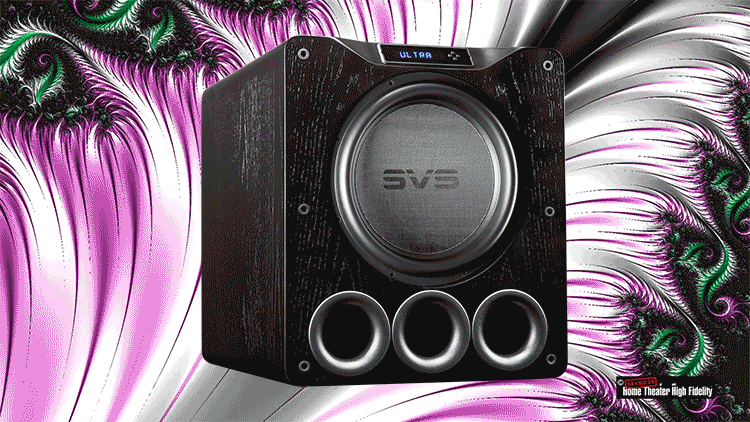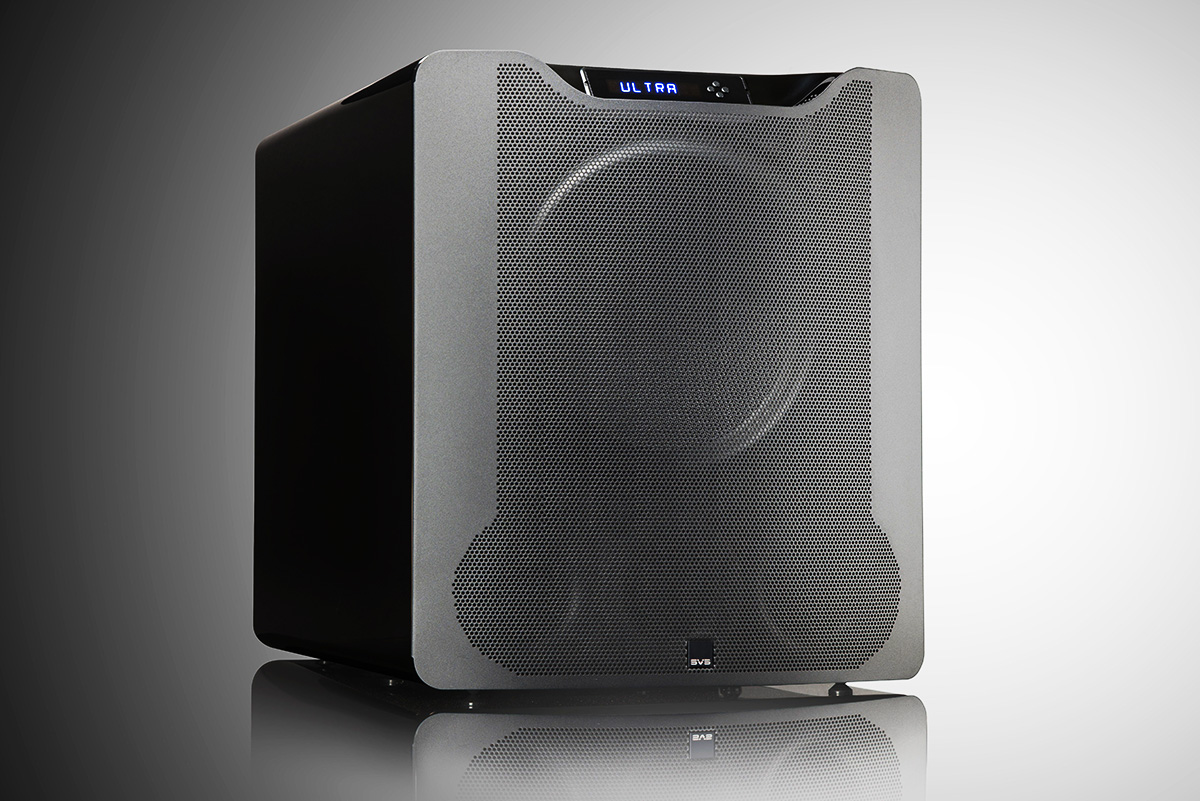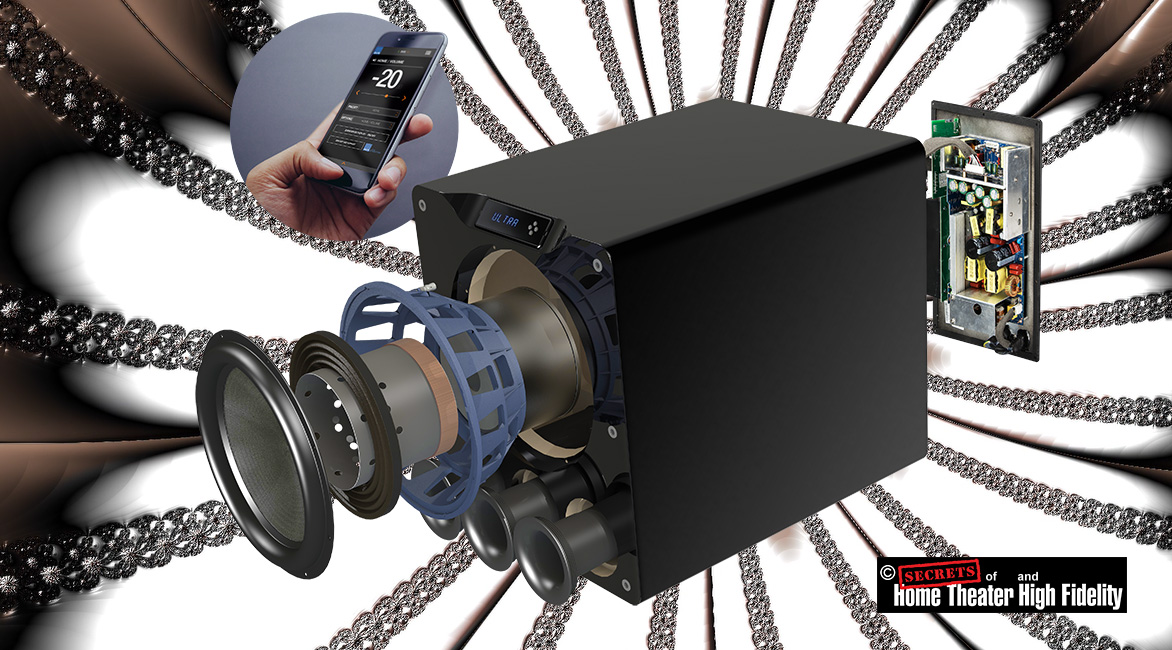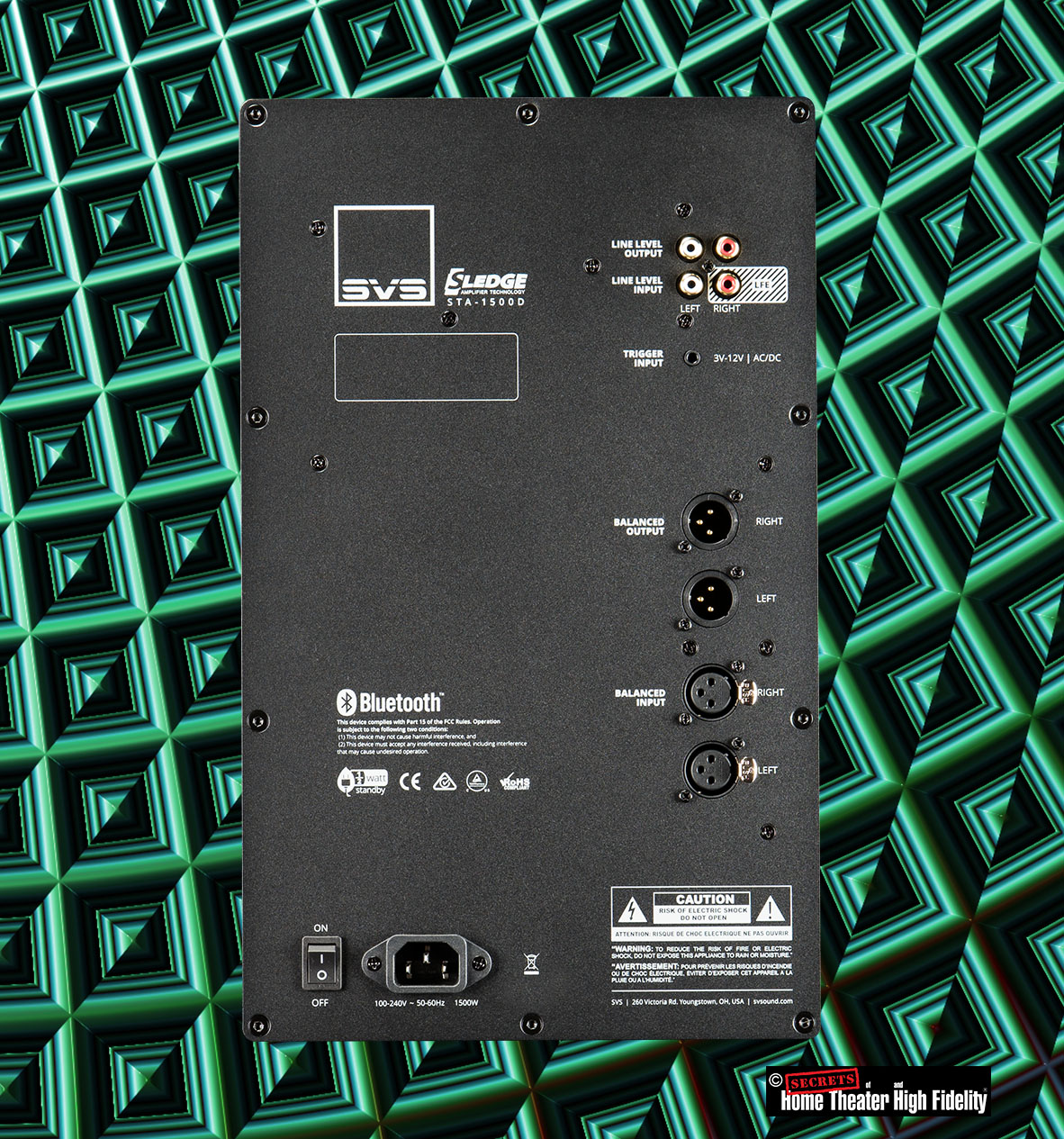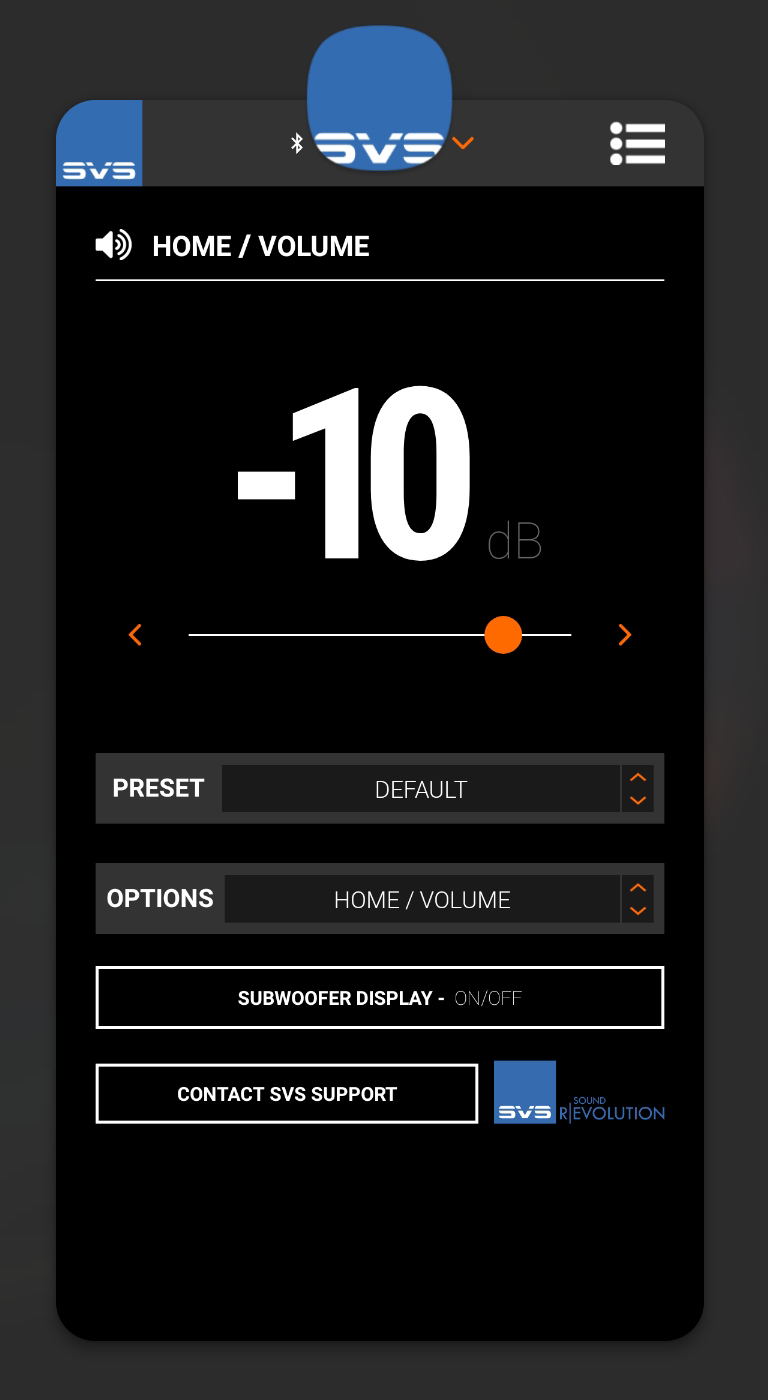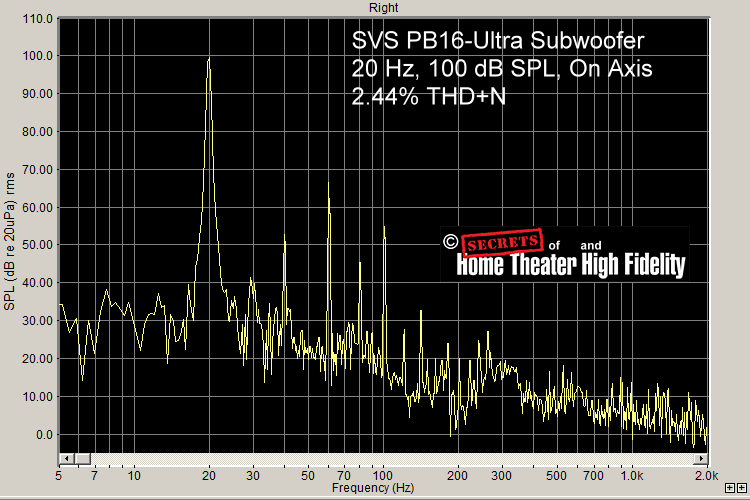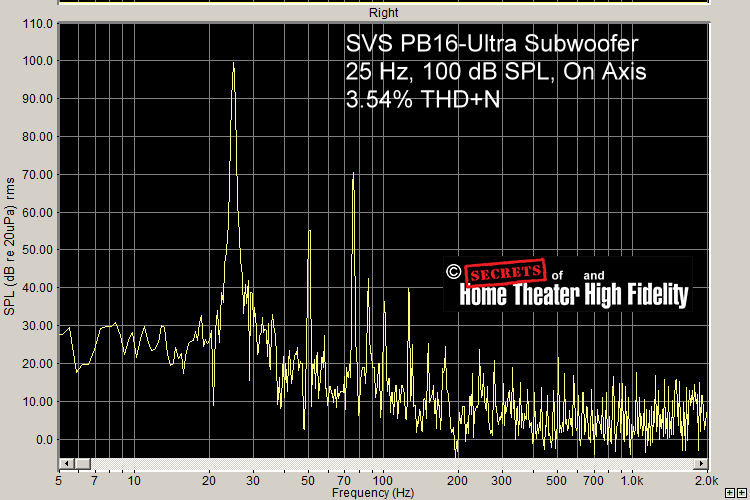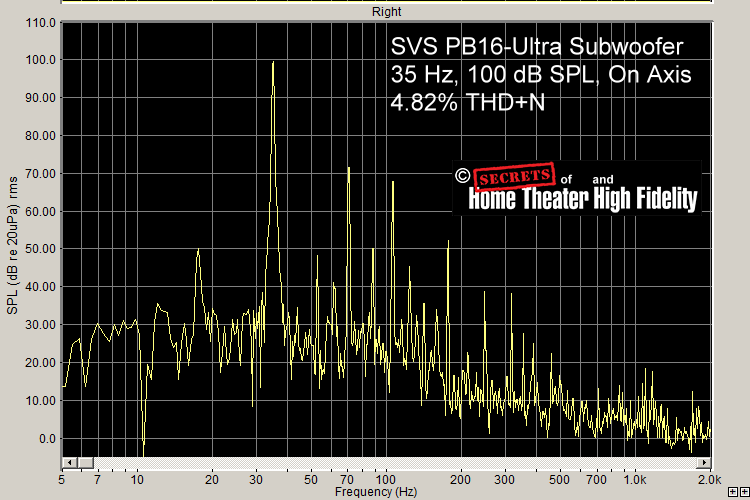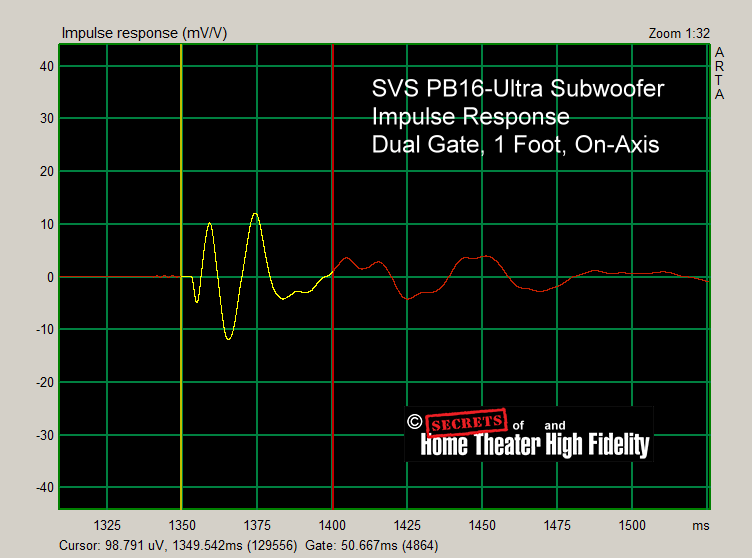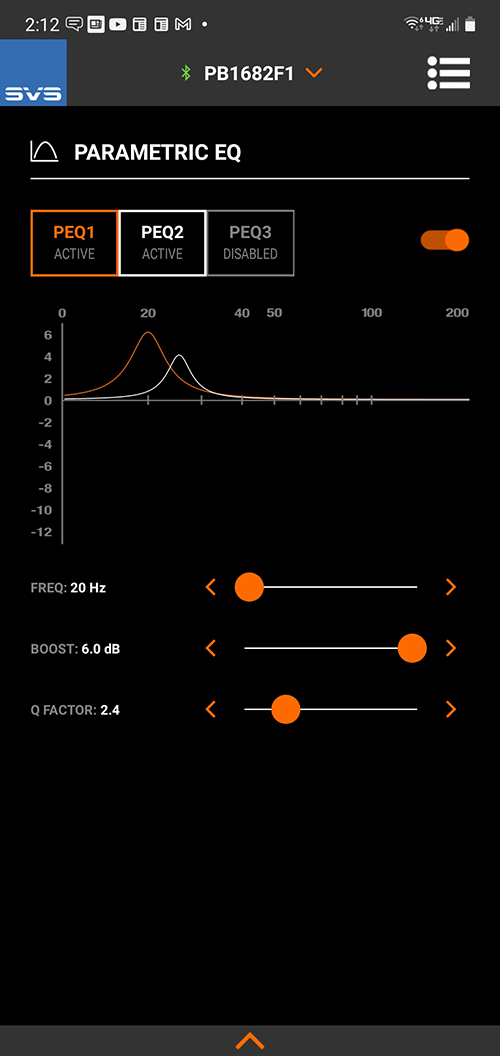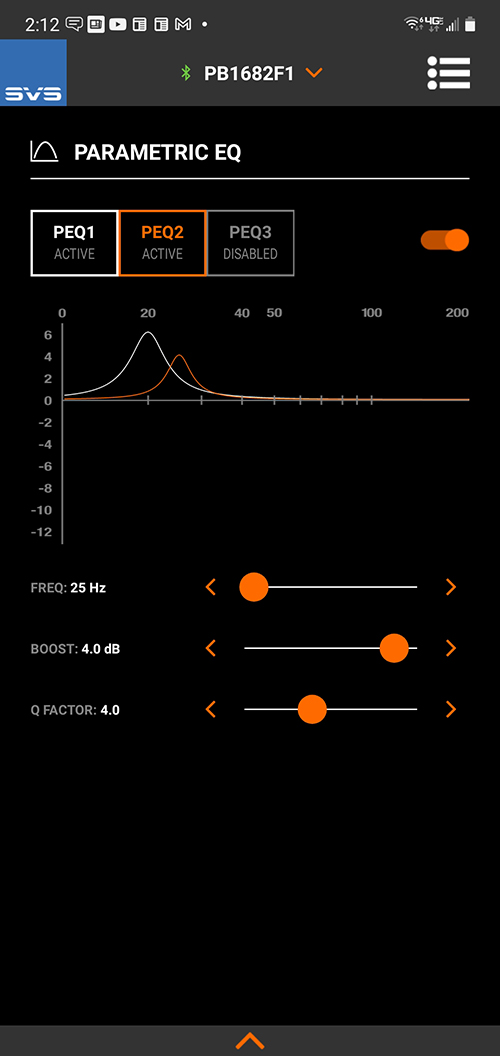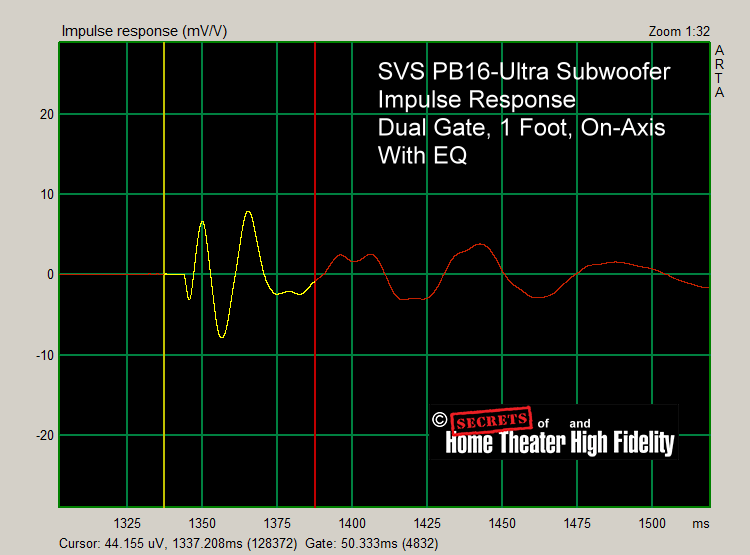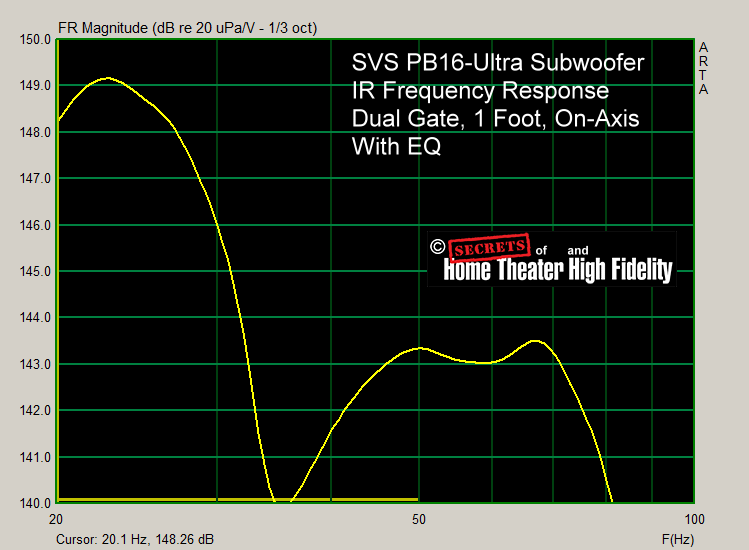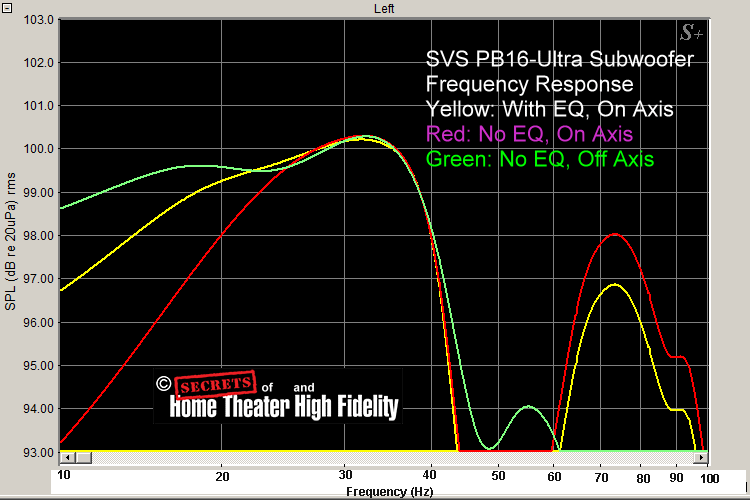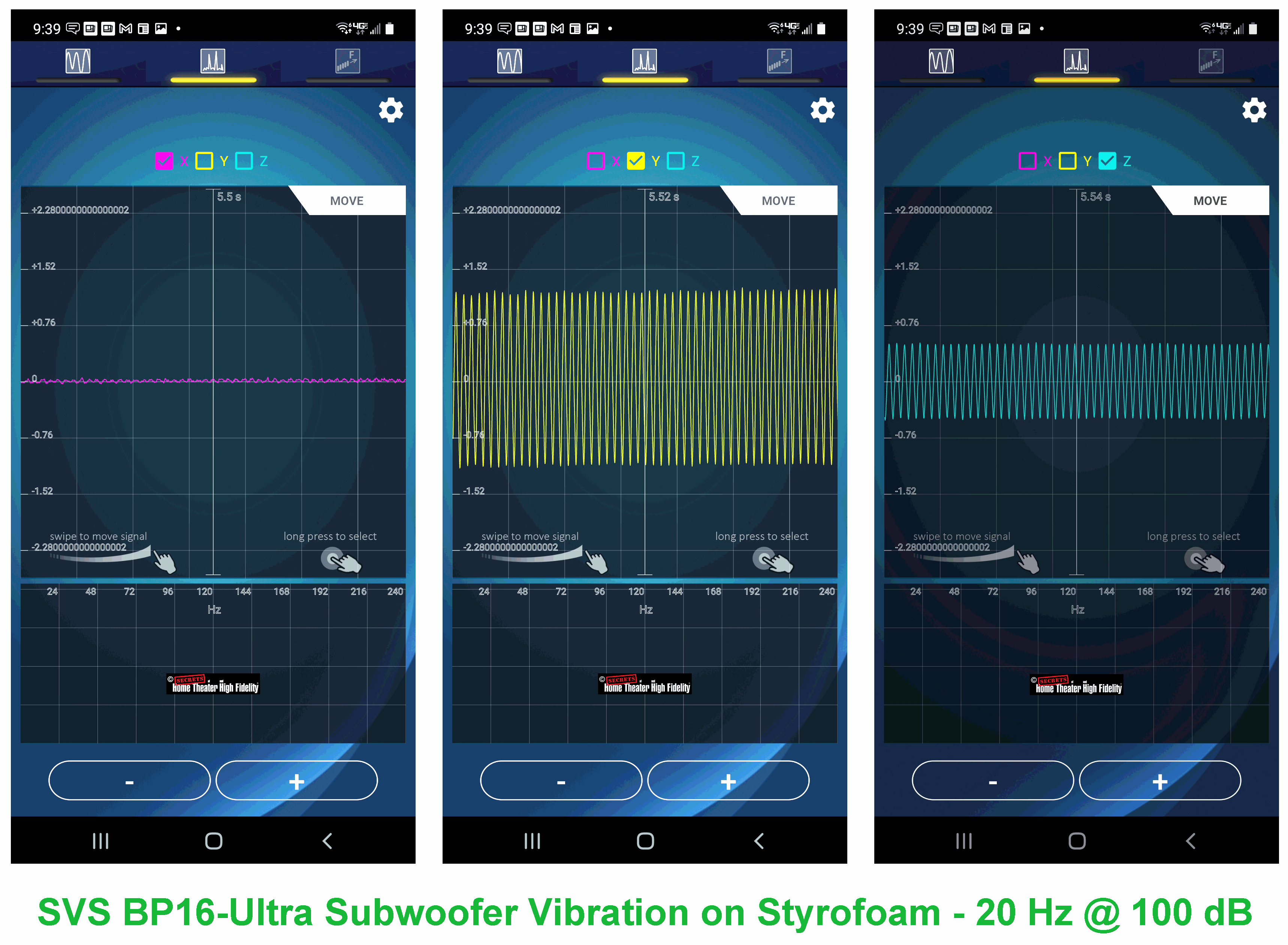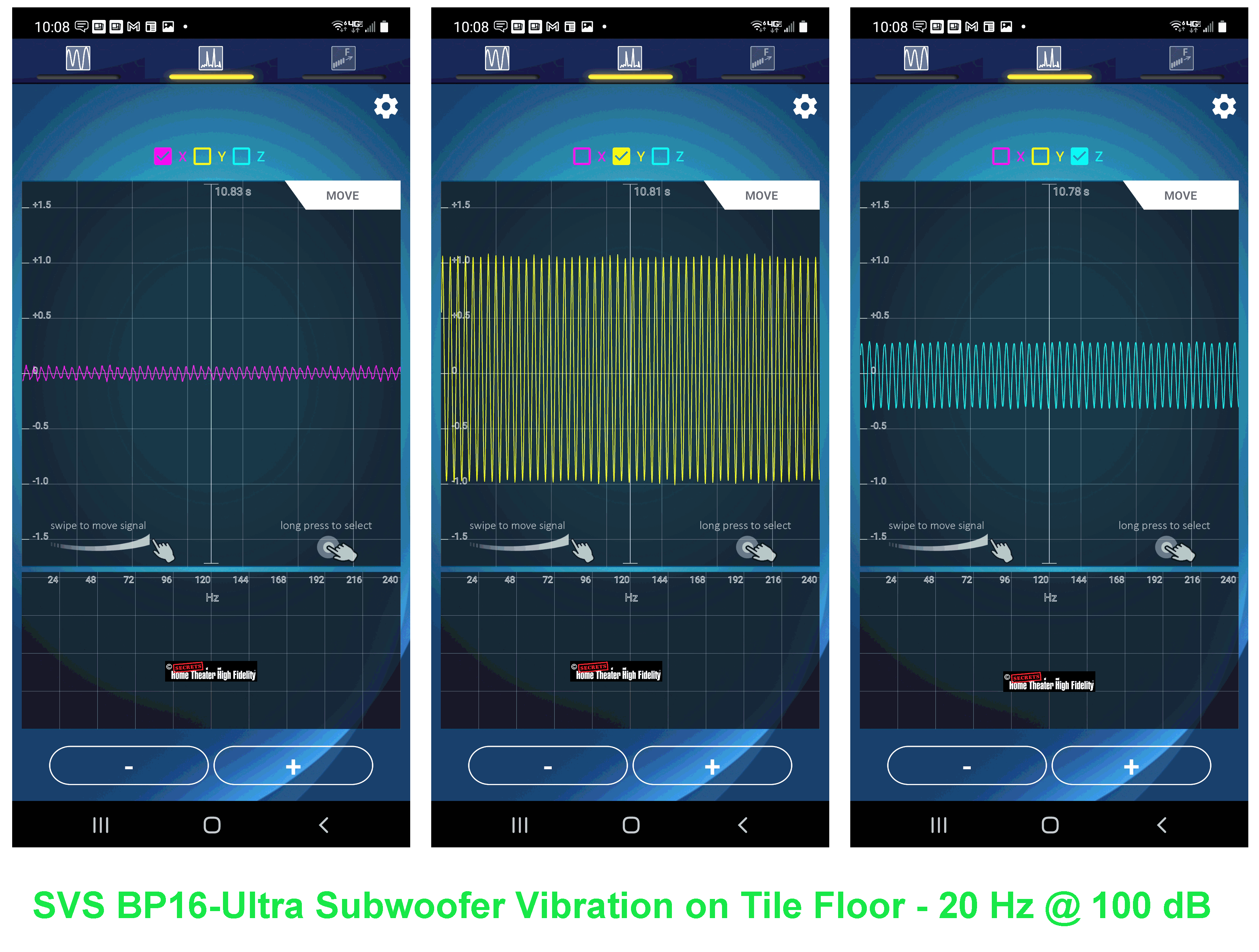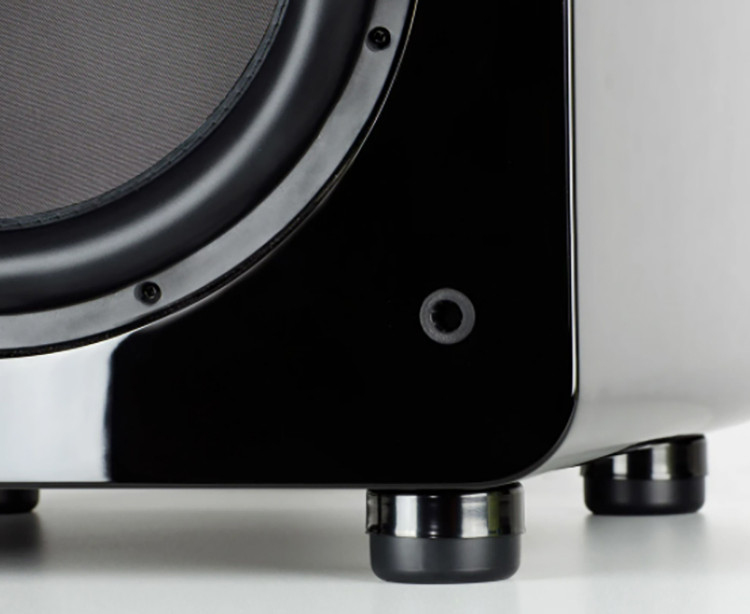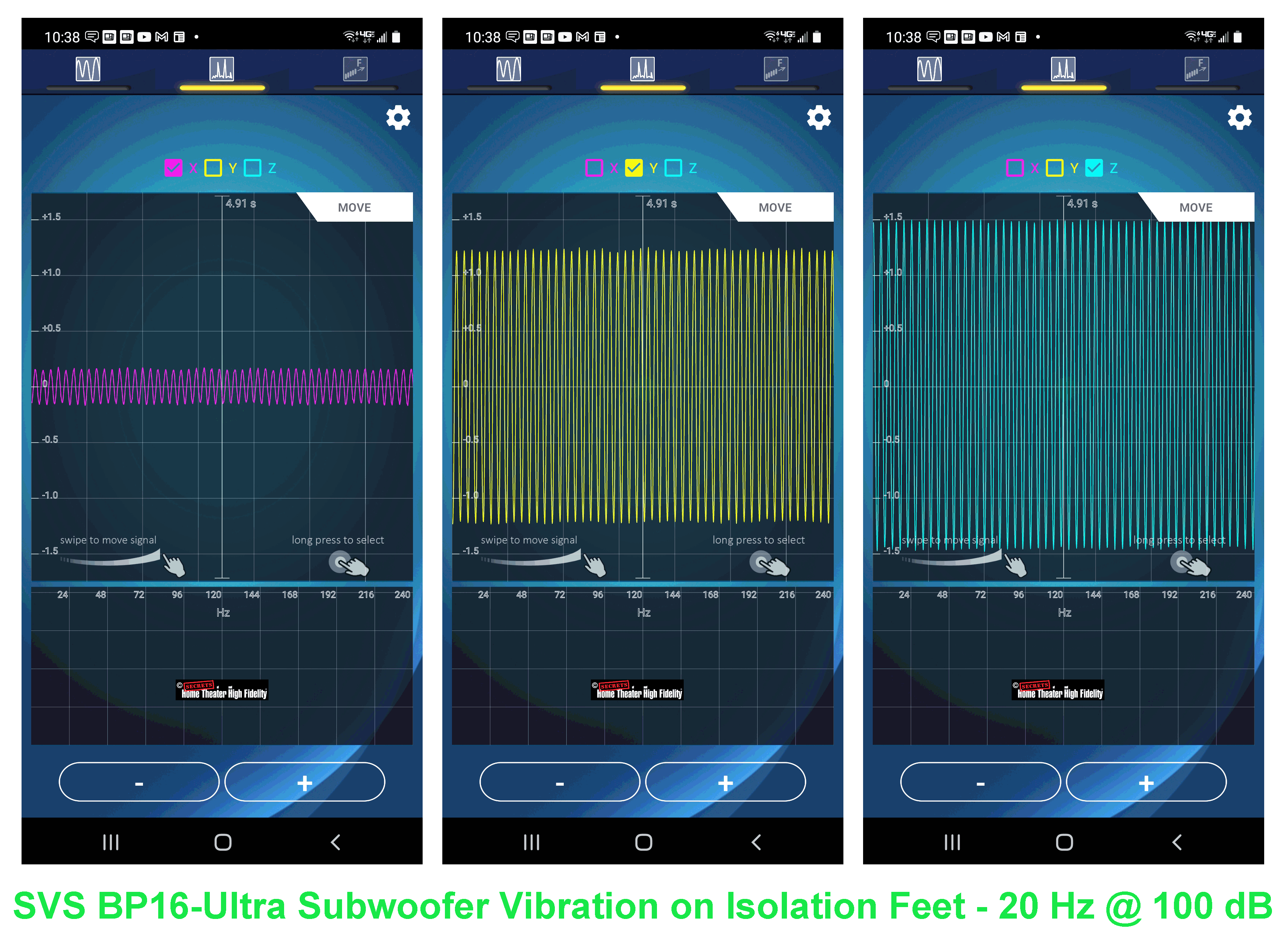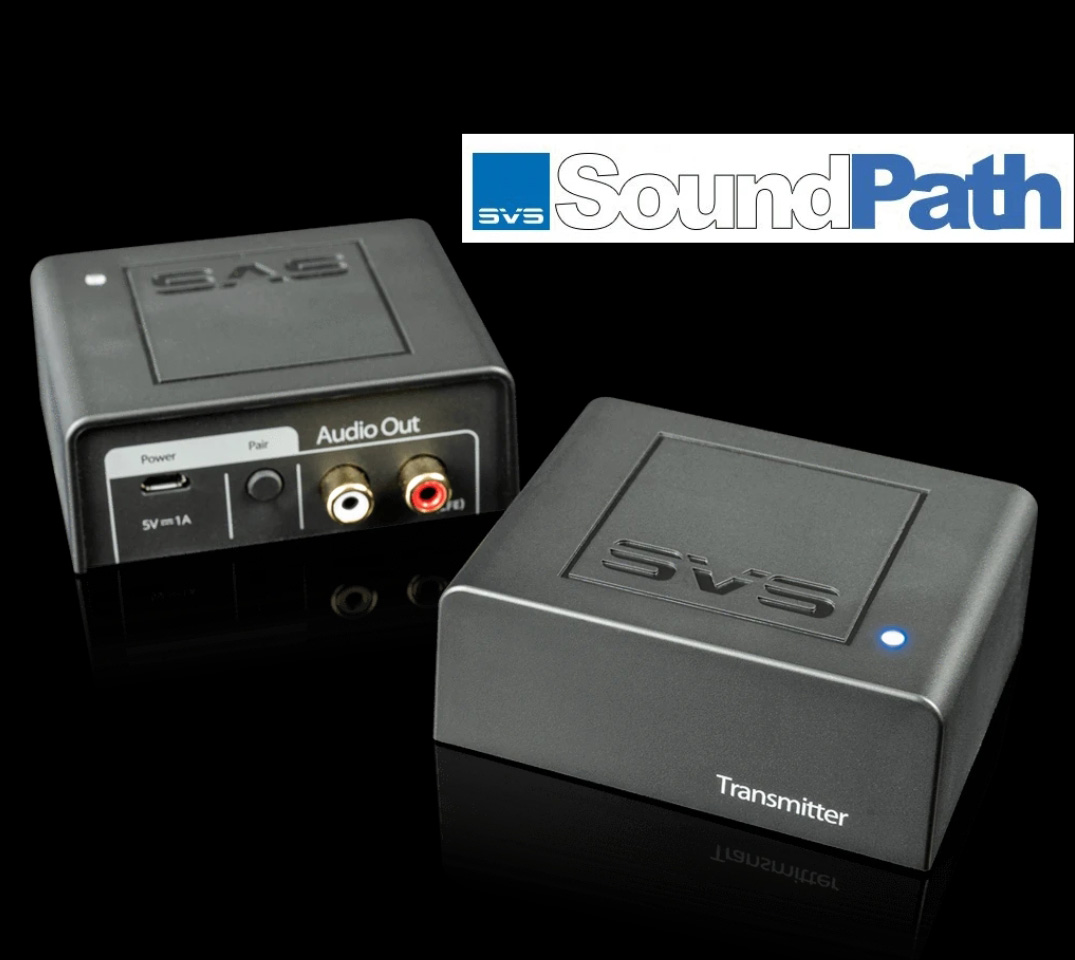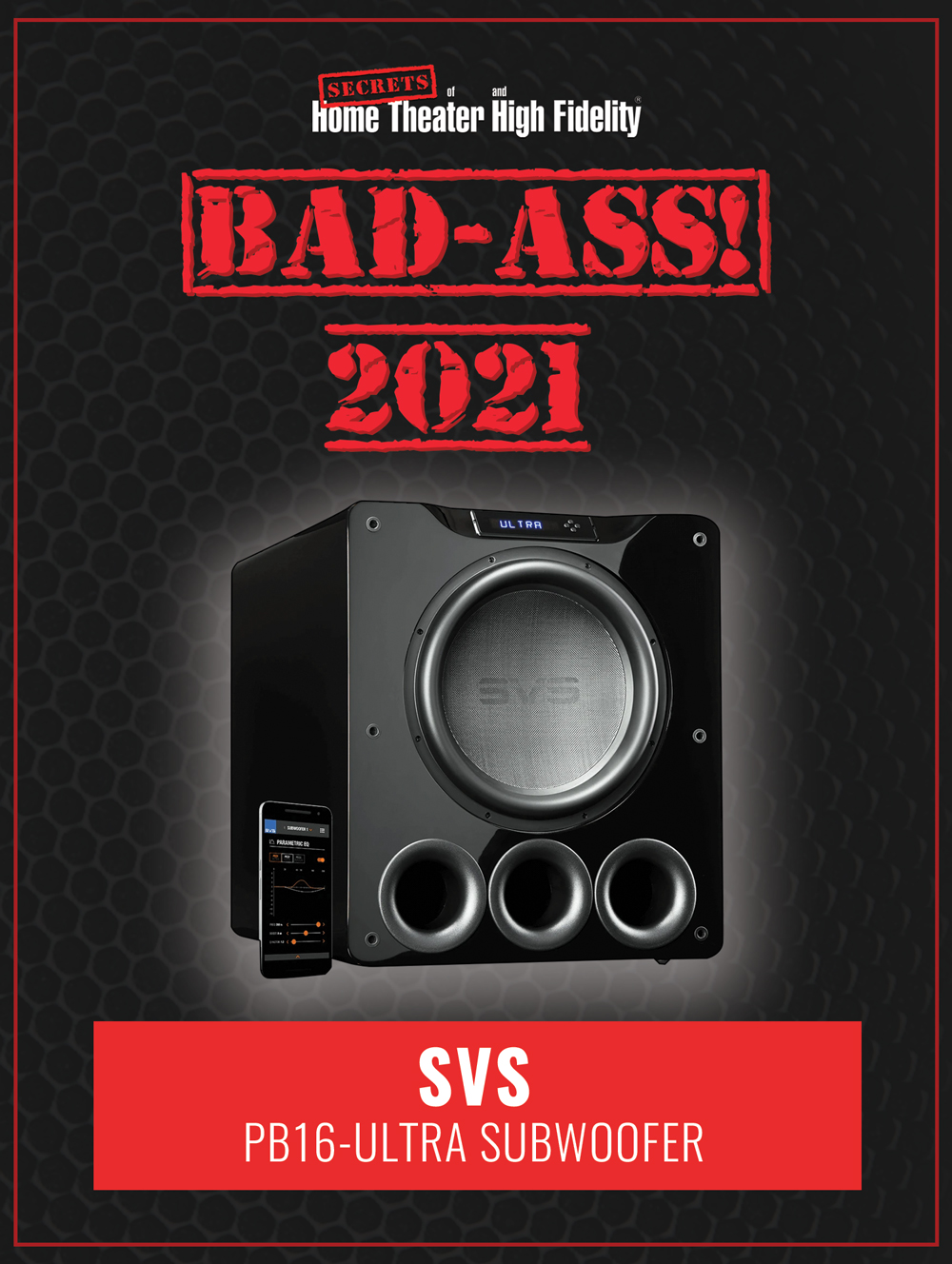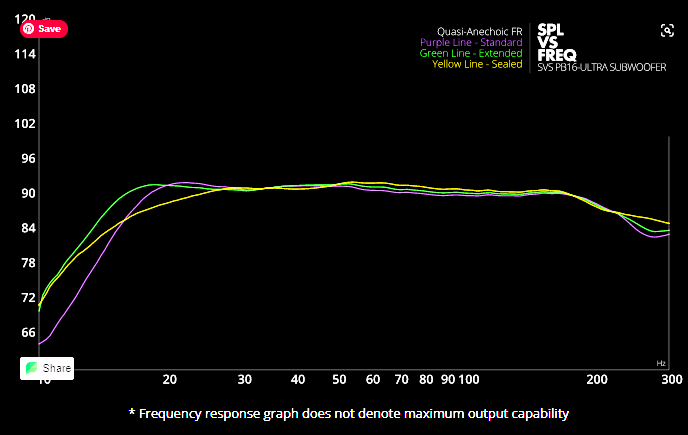SVS PB16-Ultra Subwoofer
- Huge driver voice coil.
- Huge power amplifier.
- Astonishing performance.
- Terrific value.
SVS started out by making subwoofers several decades ago. Although they now offer speakers and other things, their subwoofers are what have made them famous.
The PB16-Ultra subwoofer is king at SVS. It is their latest iteration of no-compromise build and performance.
I recently had the pleasure – and muscle pain from lifting – of testing this beast. I may have to re-caulk my windows. At least all the cockroaches have packed up and left.
DRIVER:
Front-firing, 16” voice coil
Four ferrite magnets
95mm peak-to-peak excursion
AMPLIFIER:
1,500 Watts RMS continuous
5,000 Watts Peak
AC WALL SUPPLY:
120 Volts or 240 Volts (subwoofer automatically adjusts to either one)
FREQUENCY RESPONSE:
- 15 – 280 Hz ± 3 dB (standard mode – all ports open)
- 13-280 Hz ± 3 dB (extended mode – 2 ports open)
- 14-360 Hz ± 3 dB (sealed mode – all ports sealed)
DSP:
50 MHz Analog Devices
LOW-PASS:
30 Hz – 200 Hz
6, 12, 18, 24 dB/Octave
PARAMETRIC EQ:
Three bands
PHASE:
Continuously adjustable from 0 – 180 degrees
CONTROL:
Phone app, remote, front panel buttons
OTHER FEATURES:
Polarity switch, Three programmable pre-sets, Dedicated tuning EQs for the port configurations (plugged with foam or open), Room Gain Compensation (RGC)
DIMENSIONS (with grill):
25” H x 21.7” W x 30.9” D
WEIGHT:
174.5 Pounds
MSRP:
$2.899.99 USD
Website:
Company:
SECRETS Tags:
SVS, Subwoofer, Speakers, Audio, Subwoofer Reviews 2021
The SVS PB16-Ultra Subwoofer is an amazing design. For $2,900 you get 175 pounds of enclosure, amplifier, and driver.
The amplifier is Class D (switching) with 1,500 Watts RMS continuous and 5,000 Watts peak. If the low-frequency sound is the continuous roar of a spaceship engine, the wall 120 Volts AC will probably drop a bit, but if the sound is short, you should get pretty close to what the amplifier is capable of producing, which means you will get to listen to your wall studs vibrating and feel your house foundation shaking. I say that because that is what I experienced.
You can see a diagram of the driver’s parts below. The voice coil is very large (8” diameter}, and the magnet that it surrounds is also large. This results in a lot of magnetic flux which means force that pushes the cone forward and draws it backward. Since a subwoofer cone is much heavier than a midrange driver cone or tweeter cone, this helps combat the force of inertia. Remembering your physics, inertia resists starting the cone forward and resists stopping it and pulling it backward, so high flux will decrease distortion that would otherwise be produced by that inertia.
You need a powerful amplifier to produce that flux in the voice coil, and the PB16-Ultra has it.
Secrets Sponsor
The photo below shows the parts of the driver. The magnet on this beast weighs 56 pounds (the entire driver weighs 63 pounds). That is very heavy. Together with the 8” diameter voice coil attached to the rear of the cone, this produces the magnetic flux that drives the cone forward and backward. Because a heavier cone has more inertia, the 1,500-watt power amplifier together with the large voice coil and heavy magnet can push the cone forward and draw it backward with greater energy, and that will reduce distortion.
Voice coils are glued to the rear of the cone, and when they push the cone forward or pull it backward, the cone flexes, and this causes distortion in the waveform. The 8” voice coil in the PB16-Ultra is glued in a circle that is halfway between the center of the cone and the outer edge. This stiffens the cone and reduces the flexing compared to what happens with a smaller-diameter voice coil. A larger voice coil also means it can handle more voltage and current with less over-heating.
The input impedance on the amplifier is 22 kOhms both on the RCA input and XLR balanced input. The amplifier is balanced from input to output. The impedance of the driver is 4-5 Ohms.
The home page for the phone app for controlling the PB16-Ultra looks like this: You can control the volume, select presets that have settings you prefer, and control other options such as low-pass crossover frequency and EQ. There is also an included remote for basic things such as volume. I prefer the phone app because it has more extensive options and I always have the phone in my pocket anyway. However, the app connects to the sub by Bluetooth, so if you are across the room, that might be too far to communicate.
For the listening tests, I used an OPPO UDP-205 Disc Player, Otari MX-5050B-III-2 RTR tape deck, Classé SSP-800 Surround Sound Processor, Two Pass Labs Xs 300 Monoblock Pure Class A Power Amplifiers, Four Pass Labs X600.8 Power Amplifiers, Classé CA-5200 Five-Channel Power Amplifier, MartinLogan CLX Full-Range Electrostatic Speakers (front), MartinLogan Summit X Hybrid Electrostatic Speakers (rear), three MartinLogan Stage X Hybrid Electrostatic Speakers (sides and center), and a Sony 75″ UHD (4K) Flat Panel Display. The cables were from Clarus Audio. Clarus Concerto Power Conditioner with Crimson Power Cable.
Complete List of Reference Components: OPPO BDP-105 Universal Player (4), OPPO UDP-205 Universal Player (2), VPI-HR-X Turntable with Sumiko Starling and Palos Santos MC Cartridges, Otari MX-5050B-III-2 Reel-to-Reel Tape Deck, AURALiC ALTAIR G1 Digital Audio Streamer, Manley Labs Steelhead Tube Phono Preamplifier (2), Balanced Audio Technology VK-5i Pure Class A Triode (Tube) Stereo Preamplifier (2) (Fully Balanced), Balanced Audio Technology VK-500 Solid State Stereo Power Amplifier (Fully Balanced) (250 Watts per Channel), Pass Labs Xs Stereo Preamplifier, Pass Labs XP-20 Stereo Preamplifier, Pass Labs XP-27 Phono Preamplifier, Pass Labs Xs 300 Monoblock Pure Class A Power Amplifiers (2) (300 Watts/each), Parasound JC 1+ Monoblock Power Amplifiers (2), Lamm LL1 Signature Stereo Pure Class A Triode (Tube) Preamplifier, Bryston BR-20 Stereo Preamplifier, MartinLogan CLX Full-Range Electrostatic Speakers (2), Sonus faber Lilium Speakers (2), Paradigm Reference Signature SUB 2 Subwoofers (2), Custom-Built Computer for Audio Analysis, Accupel HDG-3000 Digital Color Signal Generator (1080i capable), Component Video and DVI Output, ColorFacts Pro Video Test and Calibration Software, Version 6.0, Spyder Sensor, SpectraPlus Audio Analysis Software, Audio Precision SYS-2722 Spectrum Analyzer, Staco 3PN2210B-DVM 22 Ampere Variable Transformer (for adjusting line voltage to 120 volts during amplifier power output tests), Classé SSP-800 Surround Sound Processor, Emotiva XMC-1 Surround Sound Processor, Classé CA-5200 Five-Channel Power Amplifier (200 Watts per Channel), Pass Labs X600.8 Power Amplifiers (4) (600 Watts/Each), Audio Control Phase Coupled Activator (Sub-Harmonic Generator), Carver Platinum Mark IV Ribbon Speakers (2), MartinLogan Summit X Hybrid Electrostatic Speakers (2) (Rear Left/Right), MartinLogan Stage X Hybrid Electrostatic Speakers (3) (Center and Sides Left/Right), MartinLogan Balanced Force 212 Subwoofer, Velodyne DD-18+ Subwoofer (3), HiFiMAN HE1000 Planar Magnetic Headphones, OPPO PM-1 Planar Magnetic Headphones, Sennheiser HD 660S Headphones, OPPO HA-1 Headphone Amplifier, Bryston BUC-1 USB Converter, Sony VPL-HW55ES 1,920 x 1,080p Digital Projector, 90″ (Diagonal) Stewart Grayhawk Projection Screen, Sony 75″ UHD (4K) Flat Panel Display, Clarus Audio Cables, Clarus Concerto Power Conditioner with Crimson Power Cable.
Note: I have a very large array of reference equipment items as is evident in the paragraph above. This is because I feel that if I had only one reference setup, I would be biased towards the sound of that setup when listening to review products. Any deviation from the sound of that reference kit that I am used to might be interpreted as not being good. So, I alternate between the array of reference items that I have in order not to be biased towards any particular sound. It works for me.
When using the PB16-Ultra, it is important to remember that your processor or preamplifier with subwoofer outputs has low-pass crossover settings as does the PB16-Ultra, so use the crossover setting in either the processor or subwoofer, but not both at the same time. If you want to use the setting in your processor, simply inactivate the low-pass setting in the SVS app.
Copland – Fanfare for the Common Man – Telarc – CD
For deep bass in an orchestral piece, this Telarc recording does the job. I have searched through many recordings of this composition, and this particular one is the most thunderous. It is a real test. The opening bass drum thuds with the PB16-Ultra sounded just as I like to hear it. Windows rattle, floors creak, foundations other than those in the building where my lab is located shudder. My wife could feel it in the main house which is about 30 feet from my lab. The PB16-Ultra handled them with ease and tremendous depth.
Movie – Guardians of the Galaxy – 2014 – Blu-ray
I am not a big fan of movies based on CGI, but this one is sure a subwoofer tester. SVS says they use this one at shows too. It had a $200,000,000 budget, and it is apparent. In outer space, Peter Quill (Chris Pratt) is chased by bounty hunters. This provides for a lot of noise and action, much of which requires a big-ass sub. Modern films with a lot of action CGI can generate sound in the 10 Hz range which the PB16-Ultra can reproduce. The SVS PB16-Ultra is receiving our Secrets Bad Ass Award for 2021. After watching this, I had to take a break from the room shaking.
Movie – Prometheus – 2012 – 4K
This is the Prequel to Alien (1979) which is generally considered one of the best Sci-Fi horror thrillers ever made. Here, space travelers try to find the origins of the human race. The sounds of the ship engines are a true test for subwoofers. It is this sort of thing that my neighbor two houses up from me can tell when I am watching movies with a lot of bass. Both of these movies were directed by Ridley Scott, and both are available in 4K, which I have.
There are a lot of WW-II movies, and I watch many of them because of my interest in WW-I and WW-II history. The SVS PB16-Ultra adds an extra punch to the battle scenes that a conventional set of speakers and small subwoofer just cannot do. Stalingrad, for example. Whoa! I really felt like I was there.
Music – Art Pepper Meets the Rhythm Section – DSD
For listening to music with just nice string bass in a jazz quintet, the SVS PB16-Ultra fits the bill for high-end audio quality. It does not have to play the bass loud to be useful. This is my favorite jazz album. I just turned down the subwoofer volume for listening to regular music. I set the low-pass crossover frequency to 40 Hz. Having a great subwoofer makes a big difference to me for this. Having a subwoofer with low distortion is really nice for listening to music because harmonic distortion in the bass is much more noticeable in music than distortion in sound effects when watching movies. It does not make much difference when there are added harmonics with cannon booms and space ship engine rumble, but with instruments like string bass, trombone, tuba, baritone saxophone, basso profondo opera singer, etc., oh yes, you can hear the distortion if it is present in high amounts. You won’t get high distortion like that with the SVS PB-16 Ultra (see bench tests below). I now consider the PB-16 Ultra to be one of the three best subwoofers I have ever listened to and bench tested. The review unit will stay here and go into my home theater permanently.
For the distortion tests, I put the microphone at 1 meter, on-axis, grill cover off. I used the Extended Mode, which means one port (the center one) had a foam plug. The other two ports did not have any plugs. Three foam plugs are included with the subwoofer. The photo below shows the SVS phone app with the Extended Mode display. The center port at the bottom has the foam plug. For these distortion tests, I turned off the low-pass crossover. This subwoofer can be connected to a 240 Volt as well as a 120 Volt wall socket. The power supply automatically adjusts for the higher voltage. I used a 120 Volt socket for the review.
At 20 Hz and 100 dB SPL, THD+N was only about 2%. This is really excellent, but having listened to the subwoofer first, I was not surprised. The 3rd ordered harmonic was the prevalent distortion peak, and at such a low frequency, this is expected.
At 25 Hz, THD+N went up substantially, and I believe this was due to standing wave interference. There is also a bit more noise, due to an increase in rattling in the room, but it is a very low level compared to the signal peak.
At 30 Hz, THD+N went down to 1%, but again, this is probably due to standing waves. Notice that the 3rd ordered harmonic is still the prevalent one.
At 35 Hz, THD+N is back up again, due to standing waves.
And at 40 Hz, there are a lot of harmonic peaks, due to standing waves. It is my opinion that the PB16-Ultra’s distortion stays at around 2% at 100 dB SPL. What I have found is that by moving the microphone around the room while a test tone is playing, the distortion varies quite a bit due to the interaction of the test tone with standing waves. When the waves overlap partially, this distorts the waveform, and mathematical deconstruction of this distorted waveform results in harmonic peaks. When I ran an Impulse Response-derived Frequency Response and Distortion measurement at 1 foot, which allowed me to plot the direct output of the driver and ports, and eliminate nearly all reflections and standing waves, distortion was less than 1% at all the low frequencies (data not shown). This emphasizes the need for a consumer to test different subwoofer locations in their listening room to obtain the best spot for hearing a smooth frequency response. This subwoofer has a great frequency response at low distortion, but standing waves can alter this depending on the location.
For the frequency response measurements using an impulse response (IR), I put the microphone 1 foot from the center of the driver (on-axis). The IR is shown below. I gated (windowed) the response at 50 msec which provides an accurate response down to 20 Hz. By placing the microphone 1 foot from the driver, I could gate 50 msec without including many room reflections. A bit of the floor reflection would be in there, but that is unavoidable. You can see the two gates (yellow and red vertical lines) which include the driver response (first peak) and the port response (second peak). I used a 100 Hz low-pass crossover for the IR tests.
Here is the frequency response, derived from the IR. The dB numbers on the Y-axis are relative, not the exact SPL. You can see that at 20 Hz, the response is down 3 dB from what it is at 27 Hz, and then the response goes down again at 30 Hz. The huge dip at 35 Hz is due to standing waves.
I tested the effect of changing the phase, which on the PB16-Ultra, is continuously available between 00 and 1800. This did not affect the dips and peaks that were caused by standing waves.
Secrets Sponsor
In the phone app, I adjusted the EQ in two bands, one at 20 Hz (first screenshot below), and the other at 25 Hz (second screenshot below). Each frequency had a different boost level (dB) and Q. The Q defines the sharpness of the peak.
So, here is the IR with EQ.
And, the IR-derived frequency response. The 20 Hz to 30 Hz region is now within 3 dB. However, the falloff above 30 Hz is greater. Standing waves cannot be denied.
Shown below is a combination frequency response test with the microphone 1-meter on-axis and 2 meters off-axis. It was obtained using a standard direct slow sweep, not an impulse response. The red line is on-axis with no EQ applied. The yellow line is on-axis with EQ applied, and the green line is off-axis with no EQ. You can see that the off-axis measurement has a flatter response than the on-axis with EQ. This is due to room gain. The frequency response changes wherever the subwoofer is moved. So, I would suggest moving the subwoofer around your room and listening to a low-frequency sweep (20 Hz – 80 Hz) in your sitting position, and select the subwoofer position that gives you the flattest listening sweep (unless of course, the best position is with the sub in the middle of the room, and in that case, negotiate with your spouse. 😄
I measured the vibration of the subwoofer sitting on several items. First, on Styrofoam, which is what I used for the bench tests due to so many things in the lab shaking when it sat on the floor. The test signal was 20 Hz at 100 dB when the microphone was 1-foot on-axis. I used a phone app that measures vibration in three directions (axes), and the phone was resting on top of the subwoofer, in the middle, with the top of the phone at the rear. So, the results for the X-axis are vibrations from side to side, the vibrations on the Y-axis are from the front-to-rear, and the vibrations on the Z-axis are up and down.
You can see that the Y-axis vibrations are the largest, which is expected since the driver cone is moving forward and backward. Click on the graphic to see a larger version. The vibrations of the enclosure are at about 17 Hz rather than the 20 Hz sine wave which is playing.
Compare the above with the vibration spectra when the PB16-Ultra was placed directly on a tile floor, shown below. The various axes are about the same, except for Z where the tile floor vibration was higher. This means less vibration was transferred to the floor.
SVS sent me a set of subwoofer isolation feet to test, called the SoundPath Subwoofer Isolation System. They come as a set of six feet for $69.99 or four feet for $49.99. I got the set of six feet. The instructions call for turning the subwoofer upside down and unscrewing the feet that are already there. Then, you put the isolation feet on and screw them in with the included set of screws. The subwoofer comes with six feet, so I would suggest getting the set of six isolation feet rather than just four.
Here are the vibration spectra for the subwoofer sitting on the file floor, but with the isolation feet.
You can see that vibration in all three axes is much larger. This means that the isolation feet keep the subwoofer vibration from being transferred to the floor. I noticed that there was less noise from other things in the room vibrating. The volume of the sine wave was perhaps a half dB louder, but that is not significant. THD+N did not change significantly either. But, as I said, vibration from objects in the room decreased which means that at least some of this noise was caused by the subwoofer vibrating the floor and that was transferred to objects, rather than all of it caused by air in the room vibrating.
This is proof of performance for the isolation feet. For $69.99, they are a bargain, and I highly recommend getting them for this subwoofer, any other subwoofer you already have, and I think they would be a good idea for your turntable too (get a set of four for your turntable). Make sure they will fit underneath the turntable plinth and also, they will not work if the motor for your turntable is on a separate mounting since the feet would raise the turntable plinth above where the motor pulley touches the platter or has a belt that goes from the pulley to the platter.
I also obtained an SVS SoundPath Tri-Band Wireless Audio Adapter kit which retails for $199.95 USD. These units are their higher-end wireless adapters that auto-switch between the 2.4 GHz, 5.2 GHz, and 5.8 GHz wireless bands. The kit consists of two small boxes, each of which has an AC adapter that plugs into a 120 V AC and connects to the wireless boxes with USB-C (cables included). After you connect the AC adapters to the wireless boxes, a steady blue light illuminates on each box, indicating that the transmitter and receiver have paired (linked together). Then you plug the subwoofer output from your surround sound processor or stereo preamp that has a subwoofer output jack into the wireless box that is labeled “Input”. You plug the output of the wireless box labeled “Output” into the input on the PB16-Ultra (turn the subwoofer off before you do this). The connecting cables are RCA male, a pair of which are included. Then, with everything on, but the subwoofer volume turned down, test the setup with a movie that has deep bass. Set the subwoofer volume control and your processor subwoofer volume control to suit yourself. The wireless boxes have the capability of transmitting stereo subwoofer signals if you have two subwoofers. This kit is capable of transmitting and receiving across very large rooms.
The frequency response and harmonic distortion for the wireless setup are shown below with about 0.2 V output from the receiver. You can see that the response is flat down to about 10 Hz. Although the frequency response is flat to 20 kHz (± 0.4 dB), the distortion amount increases at about 12 kHz to 15 kHz, so the wireless adapter could be used for full range transmission with this caveat in mind. Within a subwoofer range (20 Hz – 100 Hz), distortion stays at about 0.01% which is excellent. Notice that the primary harmonic is 2nd ordered, which is also good.
- Massive build
- Plays loud
- Plays deep
- Low distortion
- High performance-to-price ratio
- Additional EQ bands
- Custom wood veneers
The SVS PB16-Ultra Subwoofer is an amazing product. It is very big, very heavy, very powerful, and has very low distortion (for a subwoofer). I am a huge fan of big subs, and if I were setting up a home theater and wanted to have all SVS subs, I would purchase two of them, maybe three (if you purchase two sets of the wireless adapters, they can be paired separately for up to four discrete subs).
I would put them at locations different distances from walls to minimize standing waves and listen to a low-frequency sweep (20 Hz – 80 Hz) through all three of them at my sitting position and make adjustments to the subwoofer positions depending on how smooth the sweep was. I would put in a 240 Volt AC wall socket and power the subwoofers with it. Using 240 Volts will insure less voltage drop when there are high SPL low-frequency demands. I used a calibrated microphone that is designed for setting up sound systems at rock concerts and is able to handle up to 130 dB to test the PB16-Ultra at high output. I was able to get the subwoofer to output 112 dB SPL at 20 Hz at 1 foot on-axis, even with a 120 Volt wall AC supply. I then tested the sub with a 240 Volt supply, and it did not sound any different at 112 dB than with a 120 Volt supply. It could have been driven louder, but that was as loud as I could stand it in the room, and everything was shaking, buzzing, and vibrating. However, with multiple subs, the 120 Volt supply would definitely have dropped. Getting it to output 112 dB even at 120 Volts is testimony to the very powerful amplifier that this subwoofer has.
The SVS PB16-Ultra is a dynamite subwoofer, and it has received our Secrets Bad Ass Award for 2021.
Thanks for the in-depth review, it really shows a passion for great sound and shows your belief in the value of subwoofers in general.
In response to the measurements, we definitely agree with your assessment that the room acoustics are impacting some of the data in the THD and frequency response measurements.
At SVS we use a variety of scientific acoustic measurement systems and spaces to objectively evaluate the frequency response, THD, and CEA-2010 performance among other tests. We always perform these tests in some kind of anechoic space free of room reflections, acoustic boundaries, and other elements that alter the objective performance. In-room measurements are an important tool for tuning the performance of the subwoofer for a specific room, subwoofer placement, and listening position.
Included below is the frequency response of the PB16-Ultra measured at a 2-meter distance in a large open outdoor ground-plane space free of reflective surfaces. Like CEA-2010, this is an industry-standard for evaluating the tuned frequency response of the system free of any impacts from room acoustics.
As always, the SVS support team is standing by 7-days-a-week to assist users with proper subwoofer placement, setup, and calibration to achieve the best performance possible. The room can significantly affect performance but there are always steps the owner can take to mitigate these issues and we’re standing by to help.


